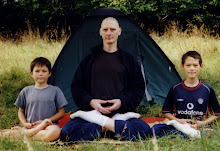Reply to a Mate in Zazen
I would like to ask about the Alexander technique in relation to zazen. How do you sit in zazen?
Could you put it down as accurately as you can in words? Possibly with diagrams. I know its impossible since words are ultimately limited, but if you can describe the posture as accurately as you can, that would be better than nothing.
You see, I live many hundreds of miles from England and have no money to visit you. I wish I could understand the FM technique in regard to zazen.
Thanks mate.
*******
My reply:
Good to hear from you, mate.
I’ve been suffering from gastric flu for the past couple of days, but reading your post has given me a lift.
Your question is a very good one. At the same time, it shows you haven’t understood what I wrote in the original post that Alexander work is the most mental thing there is. But how could you understand, only by me writing about what you haven’t experienced?
Master Dogen wrote: Sit in the full lotus posture, bodily, mentally, dropping off body and mind.
What you are asking me is how to sit bodily. You want to know what to do. Good for you. That is already described for you in Fukan-zazengi: cross the legs, thumbs together, sit upright without inclining, eyes open naturally, tongue against the roof of the mouth, et cetera, et cetera.
How to sit mentally is a more subtle thing. It has to do with “not doing” and, ultimately, “non-doing.”
People think Alexander work is primarily about body posture. It isn’t. It is the most mental thing there is. Alexander work is an exercise, Alexander used to say, in learning what thinking is. Alexander thinking is not intellectual thinking. It is not even necessarily verbal thinking. It is not what people understand by thinking. In that sense, you could call it “non-thinking.”
Even though it is not necessarily verbal thinking, when we put it in words, we express it something like this:
“I wish to allow the neck to be free, to allow a freeing of the head in a forward and upward direction, in such a way as to allow a freeing of the spine in a lengthening direction and a freeing of the back in a widening direction.”
So yes, it is about the neck, the head, the spine, the back. But more than that it is about thinking/non-thinking. It is about intending to allow a freeing.
So, sorry mate, no diagrams. What kind of diagram do you want me to draw to express intending to allow a freeing?
Master Dogen instructed you: Bodily sit in lotus. That is telling you to do it. (Doing.)
Master Dogen instructed you: Mentally sit in lotus. That is telling you NOT to do it. (Not doing.)
Master Dogen instructed you: Dropping off body and mind, sit in lotus. That is telling you to allow IT to do you. (Non-doing.)
For example, take the direction to allow the head to go forward and up. This doesn’t mean to do something to get the head to move or change position. Alexander observed a universal tendency among civilized people to stiffen the back of the neck and pull the head back and down (so that the neck column is pulled forward and the chin is pulled up).
Gudo also is well aware of this as a postural tendency requiring re-education. But Gudo’s approach and Alexander’s approach to postural re-education are totally different.
According to Gudo, we should counter the tendency for the neck to slump forward and the chin to be pulled up, by doing something. We should tuck the chin in and try to keep the neck bones as straight as possible. This is doing.
Alexander’s principle is that the pulling the head back and down is already a doing. In order to be free from that tendency, we should not do it, and not do anything to counter it either. Rather we should NOT DO (i.e. think) the opposite direction (forward and up), to allow the head to be released out of the body’s habitual tendency to pull the head in.
If you are the same as everybody else, you will have the habit to pull the head back and down, and if you try to stop yourself doing that, you will give yourself a headache by doing some variation on the same theme of pulling the head back and down. Gudo’s method of straightening the neck bones and tucking in the chin, from Alexander’s viewpoint, is just another variation on the theme of pulling the head into the body -- the very opposite of the freeing that we really want.
I don’t expect you to understand any of this. But I hope that you sense that I am struggling to express something real, which I am.
It is a hell of a struggle, but it is worth it, because what Alexander discovered is something very very real. True, good, and real.


0 Comments:
Post a Comment
<< Home